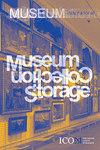Collections Emerge from the Shadows: Exhibition Design, or a Multi-sensory Approach to Reinvesting in Collections
IF 0.4
4区 艺术学
0 ART
引用次数: 1
Abstract
Abstract The event-driven imperative for art museums has led some to fear the decline of permanent collections in favour of temporary exhibitions. However, recent studies have highlighted new museum practices that aim to promote permanent exhibitions through various strategies, such as carte blanche artist projects, artist residencies and performances. Art collections therefore seem to be emerging from the shadows. In that context, this article studies another phenomenon concerning the enhancement of art collections through various exhibition design practices. What are the intentions behind, reasons for and impacts of these strategies on the display of permanent exhibitions? To explore this question, the author examines the renovations of three museums: the Nationalmuseum in Stockholm, the Islamic Gallery at the British Museum in London, and the twin ‘Leonardo’ and ‘Raphael and Michelangelo’ rooms at the Uffizi Gallery in Florence. The results support the idea that volume, colour, lighting and décor constitute a multi-sensory language of exhibition design that creates an aesthetic and emotional experience for visitors. These strategies are inherited from experience with temporary exhibitions but also from past practices in the display of collections. In this sense, these emerging trends suggest that museums are reinvesting in their art collections through an exhibition design approach oriented towards the public experience.从阴影中浮现的藏品:展览设计,或藏品再投资的多感官途径
摘要艺术博物馆的事件驱动的必要性导致一些人担心永久藏品的减少,而倾向于临时展览。然而,最近的研究强调了博物馆的新做法,旨在通过各种策略促进永久展览,如全权委托艺术家项目、艺术家驻留和表演。因此,艺术收藏似乎正从阴影中浮现出来。在这种背景下,本文研究了通过各种展览设计实践来增强艺术收藏的另一种现象。这些策略背后的意图、原因以及对常设展览展示的影响是什么?为了探讨这个问题,作者考察了三家博物馆的翻新情况:斯德哥尔摩国家博物馆、伦敦大英博物馆的伊斯兰美术馆,以及佛罗伦萨乌菲齐美术馆的“莱昂纳多”和“拉斐尔与米开朗基罗”双室。研究结果支持了这样一种观点,即体积、颜色、照明和装饰构成了展览设计的多感官语言,为游客创造了美学和情感体验。这些策略既继承了临时展览的经验,也继承了过去藏品展示的做法。从这个意义上说,这些新兴趋势表明,博物馆正在通过面向公众体验的展览设计方法对其艺术藏品进行再投资。
本文章由计算机程序翻译,如有差异,请以英文原文为准。
求助全文
约1分钟内获得全文
求助全文
来源期刊

MUSEUM INTERNATIONAL
ART-
CiteScore
0.60
自引率
0.00%
发文量
0
期刊介绍:
In its new revised form Museum International is a forum for intellectually rigorous discussion of the ethics and practices of museums and heritage organizations. The journal aims to foster dialogue between research in the social sciences and political decision-making in a changing cultural environment. International in scope and cross-disciplinary in approach Museum International brings social-scientific information and methodology to debates around museums and heritage, and offers recommendations on national and international cultural policies.
 求助内容:
求助内容: 应助结果提醒方式:
应助结果提醒方式:


